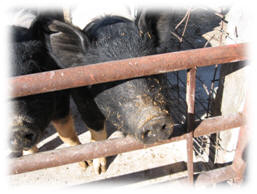Adaptations:
Skeleton
Pigs have extremely rugged skeletons. These rugged skeletons support greater weight, in proportion to size, then any other farm animal. Breeders are continuously attempting at keeping a balance between fineness of bone and the amount of weight it can support.
Breeders also watch the overall shape of the pig. Among the changes that can occur is the length of the body, which is usually related to the number of rib bones the pig contains. Longer pigs, usually used for bacon, have pairs of ribs from 13-17. Sometimes a pig will have one additional rib on one side, but they usually come in pairs, with 14-15 ribs being the average.
 Smelling
Smelling
Pigs are always leading with their noses – this nose is like none other. The pig nose, which can be short or long, ends in a floating disk of cartilage attached to muscles. This adaptation makes the pig nose not nearly as sensitive as the human nose. This becomes important because pigs lead with their noses. Because of this adaptation pigs were commonly used to hunt underground truffles. Truffles are highly prized delicacies from the family Fungosis.
Eyes and Vision
 The pig’s eye sight is said not to be as well
adapted as other aspects of the body. Generally they have poorly
developed muscles used for sharp focusing. Pigs have the inner eye
structure called cones, in humans used for perception, but how pigs
perceive perception is unknown. Domestic pigs are the only
four-legged farm animals that do not have the inner-eye layer of
light reflecting tissue called tapetum. This is likely because the
early ancestors of the domestic pig were nocturnal. The position of
the eyes on the sides of the head do provide for good lateral vision
however.
The pig’s eye sight is said not to be as well
adapted as other aspects of the body. Generally they have poorly
developed muscles used for sharp focusing. Pigs have the inner eye
structure called cones, in humans used for perception, but how pigs
perceive perception is unknown. Domestic pigs are the only
four-legged farm animals that do not have the inner-eye layer of
light reflecting tissue called tapetum. This is likely because the
early ancestors of the domestic pig were nocturnal. The position of
the eyes on the sides of the head do provide for good lateral vision
however.
Ears and Hearing
Domestic Pigs' ear morphology varies dramatically. For example, the Landrace breed has huge and low-flapping ears in contrast to the Yorkshire which has small and erect ears. Yorkshire ears are known for the way they stand and quiver when the sows (females) are in heat and are being mounted. Pig hear very well. You cannot walk into a barn without most of the herd turning to see you walk in. They are reported to like the sound of music.
Where does Sus scrofa domestica live? Want to know? click Here


